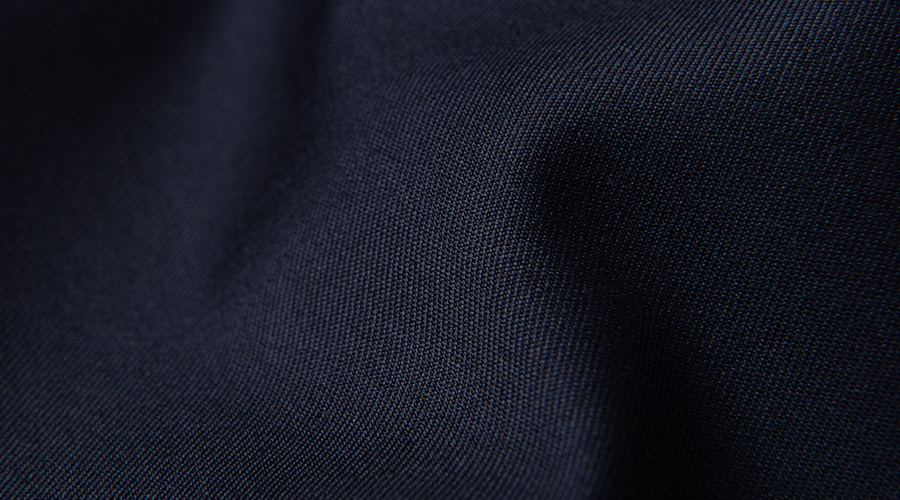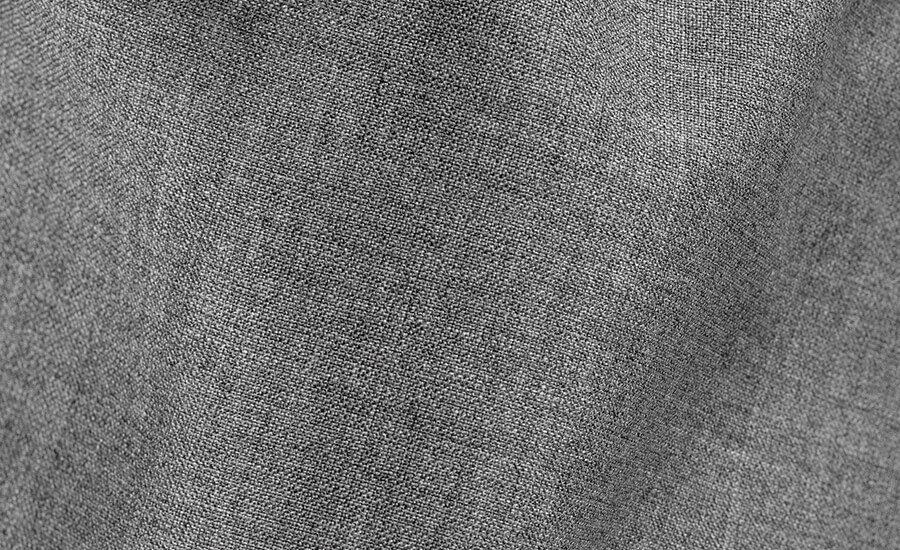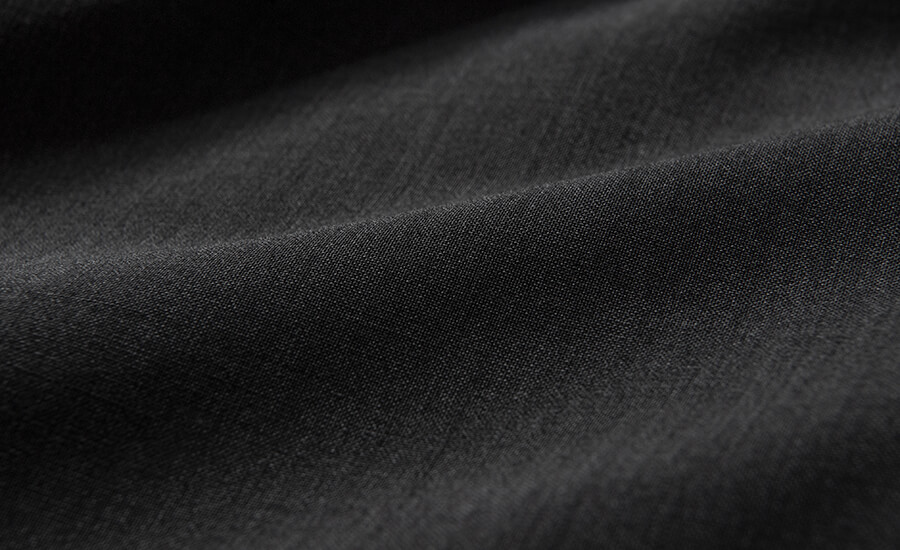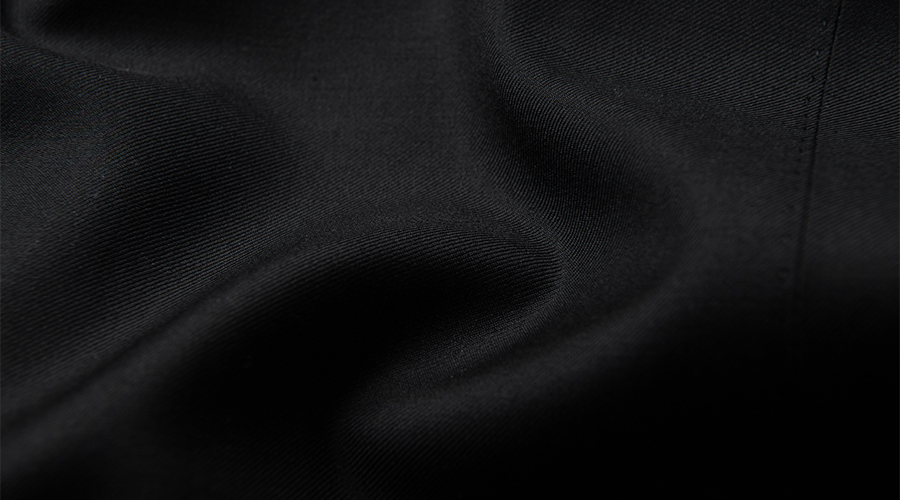Wool is the most common natural fiber used for tailored suits, jackets, and trousers. The natural properties of wool, such as its durability, breathability, odor resistance, and wrinkle resistance, make it an ideal choice for tailored clothing. Here we’ll discuss the most common types of wool suiting fabrics, as well as some of the technical terms involved in their classification.
Worsted Wool

Loro Piana Navy S130s Wool Twill
Worsted wool is the smooth suiting fabric you think of when you think of a traditional suit. It’s made from long staple wool which means the pieces of wool that make up each thread in the yarns are particularly long. This naturally reduces the number of thread ends the hand feels when touching the fabric, and therefore makes the fabric smooth to the touch. Different types of sheep produce worsted wool and woolen wool, which has a shorter staple length and results in the “fuzzy” finish associated with wool blankets and wool sweaters. Worsted wool creates the dressiest suiting fabrics and is great for all four seasons. Loro Piana’s Four Season fabrics are made from worsted wool.
“Super numbers” are often included in a worsted wool fabric’s description, and refer to the thread count of these more formal fabrics. High quality suit fabrics are woven with thread counts of 110 or higher. The “S” in front of “S110s,” for example, means “Super,” so you’d call it “Super 110s” or “110 thread count” wool, which indicates the fine nature of the threads. The majority of our suit fabrics have thread counts of S110s or S130s, with some reaching S150s.
Fresco Wool

Vitale Barberis Canonico Grey Lightweight Fresco Wool
“Fresco” refers multi-yarn high-twist wool that’s woven in a plain weave structure. The “high-twist” aspect of the fabric gives it a more open weave which creates comfortable breathability and natural stretch. Fresco wool is also naturally wrinkle resistant, which makes it a great choice for the frequent traveler, and it can be produced to be both lightweight for warmer weather and heavier for comfortable year-round wear. The wool of our fresco fabrics is not combed before the yarn is spun for a softer hand feel.
The loose weave of fresco fabrics results in a lower thread count, so they don’t usually have super numbers, although there are occasionally exceptions to this rule.
Tropical Wool

Marzotto Charcoal Stretch Tropical Wool
Tropical wools have a lightweight construction that makes them particularly breathable and therefore ideal for mild and warm climates.
While some tropical wools can also be fresco wools (and vice versa), the key difference between the two fabrics is that tropical wools are appropriate for warmer climates and weather and frescos can be lightweight too but can also be woven to be heavier and appropriate for year-round wear.
The loose weave of tropical fabrics results in a lower thread count, so they generally don’t have super numbers.
Merino Wool

Vitale Barberis Canonico S110s 100% Merino Wool Black Twill
Merino wool is grown only by merino wool sheep and is an excellent choice for year-round suiting. The naturally crimped shape of its fibers trap air, providing natural temperature regulation and quickly wicking moisture away from the body to keep you warm when it’s cold and cool when it’s hot. Merino wool has natural stretch as well, so it maintains its shape well over time. It has a smooth finish and gentle drape that make it very versatile and adaptable to most occasions, climates, and styles.
Merino wool’s fine, long-staple threads give it a high thread count, so you’ll often find that S110s or S130s wool is either 100% merino wool or contains merino wool. Many of our suits, jackets, and trousers are made with 100% merino wool, or have merino wool blended with other natural fibers. Merino wool can also be a type of worsted wool.
Wool Blends

Drago Slate Houndstooth Wool and Linen Blend
Wool is frequently blended with other natural and synthetic fibers to create different textures, appearances, and performance characteristics in suiting fabrics. For example, cashmere adds softness and warmth for cold-weather wear; silk adds strength and smoothness; and linen lightens the fabric for breathability in hot weather and creates a slubby texture. We like to experiment with different wool blends at any time of year, though our summer blend fabrics—composed of merino wool, linen, and silk—are a particular favorite for our Bedford sport coats in the warmer months.
These types of fabrics will generally not have super numbers, as the addition of non-wool materials increases the thickness of the yarns and often results in a more textured (as opposed to fine) hand.
- Must-Have Fabrics for Fall and Winter Successful seasonal dressing hinges on fabric choice. When it comes to fall and winter, dense, heavy, warm fabrics are the cornerstones of weather-appropriate style. Below you’ll find the...
- Dress Shirt Fabrics Overview Here we provide the definitive overview of the different types of fabrics commonly used in dress shirts. By understanding what the different weaves mean for a fabric you...
- Advanced Tips for Tailored Jacket Fit When it comes to the fit of your jacket, the solutions to some common issues are tough to identify. Here’s what our experts say you should keep in...
- Fabric Thickness and Weight Overview When choosing a dress shirt fabric, you may want to consider how the thickness and construction of the fabric will play a role in how warm it...